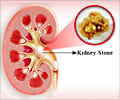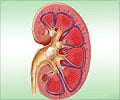
‘There is a direct functional link between collecting duct epithelial barrier characteristics, which appear to prevent leakage of interstitial osmolytes into urine, and body water homeostasis.’
Tweet it Now
For this reabsorption to work, the renal medulla that surrounds the collecting ducts must accumulate large quantities of salt and urea. Only then can water follow the osmotic gradient and be absorbed from the collecting duct into the renal medulla, where it eventually re-enters the circulation.GRHL2 makes collecting duct cells impermeable
"For the first time, we have identified an important molecular switch that is able to maintain a high salt concentration in the renal medulla," says the first author of the study, Dr. Christian Hinze of the MDC. This "switch" is the protein grainyhead-like 2, or GRHL2 - a transcription factor that can control the activity of genes.
The molecule is produced in the collecting duct cells and enables these cells to form a tight barrier between the urine and the medulla. Together with colleagues from Charité in Berlin and researchers from Kiel, Norway and the United States, the MDC scientists have now published their findings in the Journal of the American Society of Nephrology.
Genetically modified mice produce more urine
Experiments conducted in collecting duct cell cultures showed that GRHL2 has a significant impact on the permeability of the connection between cells. "Normally, the collecting duct cells form a tight barrier between the urine and surrounding tissue," says Dr. Hinze. "But cells lacking GRHL2 become permeable to certain substances." Experiments showed that collecting duct cells lacking the molecule GRHL2 become leaky and allow salts and urea to pass across cell-to-cell contacts.
Next, the scientists used an animal model to test whether these findings could be extrapolated to a living organism. They generated mice that lacked the gene encoding GRHL2 in the collecting duct system of the kidneys.
Advertisement
Kidneys failed when the mice lacked water
The increased urine production became a problem as soon as the mice had limited access to water. Their creatinine and urea levels - two important laboratory indicators of kidney function - shot up drastically. "It appeared that the kidneys of these mice were failing," says Hinze.
Advertisement
GRHL2 a potential target for new treatments
"What we found is fundamentally new information, which we can now use to further investigate conditions like diabetes insipidus, a severe and potentially devastating disease in humans," says Schmidt-Ott. This disorder involves the kidneys excreting abnormally large amounts of urine, resulting in a frequent need to urinate and to drink excessive amounts of fluids. Researchers at the MDC are now interested in finding out whether GRHL2 can be controlled in order to one day offer better treatment options for patients with disorders of their water balance.
Source-Eurekalert













